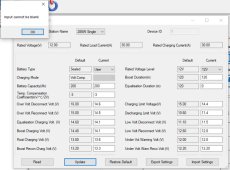Hi all,
I made my own LifePO4 battery from aliexpress raw cells. It is a 280ah.
For it, I bought the overkillsolar BMS and the epever tracer4215BN for my 2 solar panels 215 W in parallel (total 430 W).
I'd like to check with you what would be the good settings to begin with, as I have few knowledge in this domain ...
After doing some research on the forum, here are the parameters I am thinking of for my epever tracer.

In yellow, some settings I am not sure of.
Boost reconnect charging voltage, should it be higher ?
Low voltage and under voltage reconnect voltage : these are recommanded by epever. Do they seem correct ?
Discharging limite voltage , I am totally unsure of this one, as epever recommand 10,6 V , I have read it could be too agressive ... What voltage would you recommand ?
Boost duration : As my battery is 280ah, I believe with 430W solar panel I will have a low charge current. I have read in this case I could reduce the boost duration. What could it be ?
For my BMS, I used Steve's recommanded settings , for instance :
Full charge voltage / cell : 3,5 V
End of dischage / cell : 2,8 V
Discharge rate 0,2 %
For my battery protect, I am still hesitating between 10 V and 12 V for discharge limit voltage. Should it be the same settings used for my solar charge controller ?
Thank you so much for your help!
I made my own LifePO4 battery from aliexpress raw cells. It is a 280ah.
For it, I bought the overkillsolar BMS and the epever tracer4215BN for my 2 solar panels 215 W in parallel (total 430 W).
I'd like to check with you what would be the good settings to begin with, as I have few knowledge in this domain ...
After doing some research on the forum, here are the parameters I am thinking of for my epever tracer.

In yellow, some settings I am not sure of.
Boost reconnect charging voltage, should it be higher ?
Low voltage and under voltage reconnect voltage : these are recommanded by epever. Do they seem correct ?
Discharging limite voltage , I am totally unsure of this one, as epever recommand 10,6 V , I have read it could be too agressive ... What voltage would you recommand ?
Boost duration : As my battery is 280ah, I believe with 430W solar panel I will have a low charge current. I have read in this case I could reduce the boost duration. What could it be ?
For my BMS, I used Steve's recommanded settings , for instance :
Full charge voltage / cell : 3,5 V
End of dischage / cell : 2,8 V
Discharge rate 0,2 %
For my battery protect, I am still hesitating between 10 V and 12 V for discharge limit voltage. Should it be the same settings used for my solar charge controller ?
Thank you so much for your help!




